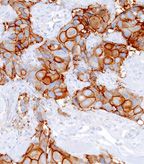Soluble HER2 Levels Prognostic Factor in HER2+ Breast Cancer
A high baseline level of soluble human epidermal growth factor receptor 2 (sHER2) was a prognostic indicator of shorter disease-free survival among patients with early-stage HER2-positive breast cancer, according to results from the North Central Cancer Treatment Group adjuvant trial N9831.
A high baseline level of soluble human epidermal growth factor receptor 2 (sHER2) was a prognostic indicator of shorter disease-free survival among patients with early-stage HER2-positive breast cancer, according to results from the North Central Cancer Treatment Group adjuvant trial N9831. In addition, high levels of the biomarkers at recurrence were found to be predictive of shorter survival.

Histopathology of invasive ductal carcinoma of the breast representing a scirrhous growth; HER2/neu oncoprotein expression by Ventana immunostaining system; source:
KGH
, Wikimedia Commons
“Our study was successful as a tool to explore the prognostic and predictive value of sHER in patients with early-stage HER2-positive breast cancer in one of the several early pivotal trials of adjuvant trastuzumab, but in no way tried to define its role in the management of such patients,” said Alvaro Moreno-Aspitia, MD, of the Mayo Clinic, in Jacksonville, Florida. Dr. Moreno-Aspitia and colleagues published the results of the study online in Cancer.
“In addition to evaluating HER2 and other molecular markers in tissue specimens, there has been great interest in serologic-based testing for circulating HER2 because of the accessibility of serologic testing and the possibility of serial monitoring for tumor response to therapy,” the researchers wrote.
However, research to date on the utility of sHER2 as a biomarker has been mixed.
Dr. Moreno-Aspitia and colleagues evaluated sHER2 levels in a series of women who had been assigned to treatment with standard chemotherapy (arm A), standard chemotherapy with sequential trastuzumab (arm B), or standard chemotherapy with concurrent trastuzumab (arm C). Baseline samples were available for 2,318 patients, serial samples for 105 patients, and samples at recurrence for 124 patients. For this study, the researchers used a cutoff sHER2 value of 15 ng/mL.
Levels of sHER2 below the cutoff value were found in 2,029 patients; 289 patients had levels equal or above the cutoff value. Women aged 50 years or older and postmenopausal women were found to have higher sHER2 levels, whereas lower sHER2 levels were found in women with hormone-receptor–positive tumors.
Despite the treatment arm, women with sHER2 levels of 15 ng/mL or greater were found to have worse disease-free survival. The hazard ratio (HR) for disease-free survival was 1.81 for arm A, 2.08 for arm B, and 1.96 for arm C.
When the researchers examined sHER2 levels at the time of recurrence, they found that sHER2 levels had increased from baseline to recurrence among the patients assigned to treatment arms A and B. However, levels of sHER2 remained the same in patients assigned to treatment arm C.
Women with levels of sHER2 at 15 ng/mL or greater at the time of recurrence had a 3-year overall survival of 51% compared with 77% in women with levels below the cutoff value (HR = 2.36; 95% CI, 1.19–4.70; P = .01).
According to Dr. Moreno-Aspitia, researchers are currently evaluating results of other large adjuvant HER2 clinical trials to determine if a number of other biomarkers that have shown promise in preclinical models have the potential to prognosticate risk of disease recurrence and predict response to anti-HER2–based therapies.
“To date, none of them have reliably been found to be of clinical significance,” he said. “Additional prospective studies are needed to further evaluate the role of soluble HER2 testing in the neoadjuvant, adjuvant, and metastatic settings, especially within the context of trials using newer HER2-directed therapies, such as lapatinib, pertuzumab, and trastuzumab emtansine.”